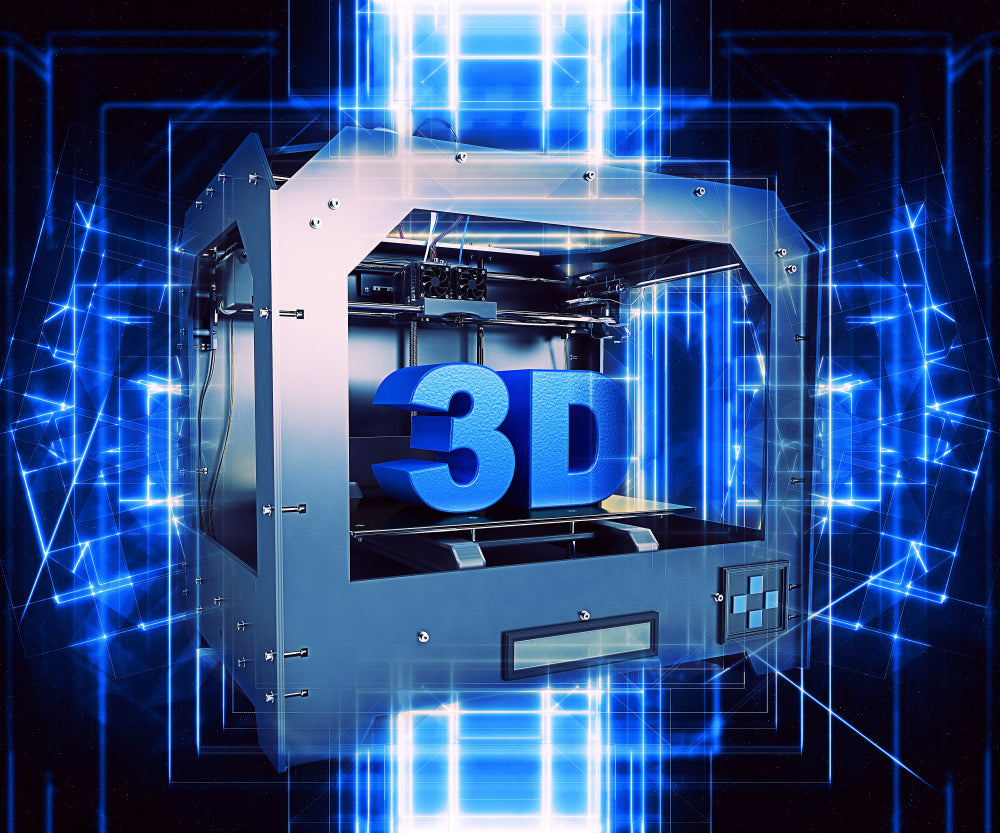How 3D Models Are Used in Different Industries?

In a world where innovation knows no bounds, 3D models have emerged as a powerful and transformative force across various sectors. These digital constructs have become the cornerstone of industries seeking to push the boundaries of creativity, communication, and efficiency. Let uncover the profound significance of 3D models used in different industries and their influence across a diverse array of fields.
I. What is a 3D Model and Its Importance in the Different Industry
A 3D model is a virtual representation crafted to encapsulate its dimensions, textures, and spatial relationships. As the heartbeat of innovation across industries, 3D models are not mere visualizations; they are gateways to immersive experiences, serving as the bridge between concepts and reality.
The strength of 3D models resides in their capacity to overcome the constraints associated with traditional media. Engineers can evaluate the durability of virtual prototypes, doctors can dissect lifelike organs, and architects can walk around virtual architecture. In contrast to 2D representations, 3D models provide an accurate picture that is completely clear. Stakeholders can easily understand complicated concepts, whether they are specialists or laypeople, which promotes consensus and well-informed decision-making.
II. In Which Industries is the Use of 3D Models Common
The realm of 3D modeling technology is a dynamic landscape that traverses a multitude of industries, infusing innovation and transforming the way we perceive and interact with the world around us. From architecture to healthcare, manufacturing to entertainment, the versatile application of 3D models knows no bounds. Lets explore the industries:
A. How Are 3D Models Used in the Automotive Industry?
3D models have become a key force in the evolving world of automotive design, propelling innovation and influencing the next generation of vehicles. The days of visualizing a car's design and function only through tangible prototypes are over. Automotive engineers and designers can create their visions on a realistic digital landscape using 3D models.
With no physical limits, 3D models make it easier to explore different design possibilities, from the dynamic curves of a sports car to the functional elegance of an SUV. The ability to play around with different shapes, sizes, and proportions on this virtual playground encourages a level of creativity that takes automobile design to new heights.
i. Streamlining the Design and Testing Process through 3D Models
Beyond aesthetics, 3D models have other uses in the car business. The entire design and testing process can be streamlined with the help of these digital creations. Without needing numerous actual prototypes, engineers can replicate real-world conditions to evaluate a vehicle's performance in various environments.
ii. Advantages of Rapid Prototyping Using 3D Printed Models
In the quest for perfection, 3D printing has turned out to be a game-changer for the car industry's rapid prototyping process. Designers and engineers may assess the shape and function in the real world using 3D printed models, which give a tangible representation of the digital design. The benefits of 3D printed rapid prototyping go beyond the design stage and include production, assembly, and even marketing, reinforcing the role of 3D models in the automotive industry's revolution.

B. How Are 3D Models Used in the Gaming Industry?
Immersion is essential in the world of gaming if you want to captivate gamers and create remarkable experiences. The heroes of this story are 3D models, which give virtual environments an unmatched feeling of depth and reality. Game designers transport players into intricate and compelling landscapes using carefully crafted 3D models, creating the backdrop for remarkable adventures. The ultimate result is a gaming experience that goes beyond the screen and immerses gamers in an infinitely imaginative world.
i. Breathing Life into Characters, Environments, and Objects
Any game's characters, settings, and objects form its core. The creative means by which these parts are given individuality, emotion, and practicality are 3D models. Characters have realistic motions and expressions that give them a sense of humanity that deeply connects with players.
Environments profit from the artistic quality of 3D modeling as well. From the grandeur of huge cities to the minute nuances of hidden rooms, these digital landscapes transform into live, breathing entities just waiting to be discovered.
ii. Realistic Animations and Special Effects through 3D Modeling
In addition to static images, 3D models are essential for producing lifelike animations and appealing special effects. Character movements, interactions, and fight scenes come to life with the help of animations, which also improve gameplay's fluidity and authenticity. Whether it's the sound of leaves rustling in the breeze or the complex physics of a challenging puzzle, environmental elements react to interactions authentically.
The gaming industry's creative toolkit is enriched by the union of 3D modeling and animation technologies, which produces a symphony of visual and interactive elements.
C. How Are 3D Models Used in the Film Industry?
The unnoticed heroes of captivating visual effects and smoothly incorporated CGI in film are 3D models. These technological innovations make it possible for filmmakers to create scenarios that take viewers to fantastical worlds and periods while blurring the boundaries between truth and fantasy. 3D models give filmmakers a wide range of tools for crafting stories, from the breathtaking destruction of cities to the development of imaginative animals.
Through the creativity of 3D modeling, visual effects that were previously thought to be unattainable become possible.
i. Crafting Breathtaking Landscapes, Creatures, and Fantastical Worlds
Cinema's charm often comes from its capacity to take audiences to stunning locations and introduce them to fascinating creatures. Filmmakers can construct entire worlds from scratch or add a touch of the fantastical to already existing landscapes through the use of 3D models, which are essential in producing these visual marvels. Every aspect of these landscapes, from towering mountain ranges to ethereal underwater realms, is meticulously designed inside the digital canvas.
ii. Role of 3D Modeling in Pre-visualization and Storyboarding
The process of turning a script into a movie requires careful planning and conceptualization. Pre-visualization and storyboarding procedures are made easier in this situation with 3D modeling. With the ability to produce visual blueprints of scenes and sequences, 3D models are useful for storyboarding, a crucial component of the filmmaking process. This makes it possible for directors and cinematographers to precisely and clearly convey their vision to the entire production team. A seamless and immersive cinematic experience is made possible by the use of 3D models, which guarantee that the original creative intent is maintained.
iii. Notable Films Showcasing the Power of Advanced 3D Modeling Techniques
In a number of noteworthy movies that have expanded the possibilities of visual storytelling, the influence of sophisticated 3D modeling techniques on the film industry is glaringly obvious. These cinematic masterpieces, from the breathtaking vistas of "Avatar" to the exquisite character designs of "Guardians of the Galaxy," owe their visual magnificence to the skill of 3D modeling. As technology develops, filmmakers have more freedom to create stories that delight the senses and take viewers to previously unimaginable places.
D. How Are 3D Models Used in the Marketing Industry?
i. Impact of 3D Models in Product Marketing and Advertisement
The marketing sector thrives on eye-catching images and 3D models have become effective tools, allowing marketers to present things in ways that conventional photography just cannot.
Viewers are able to examine every aspect from various angles to minute details. This level of involvement transcends traditional marketing strategies and gives potential customers a thorough understanding of a product's functionality and design.
ii. Showcasing Products from Various Angles and Perspectives
By enabling marketers to showcase things from many views and angles, 3D models offer a distinctive advantage in product marketing. A single 3D model may be altered to highlight various characteristics, ensuring that potential clients have a comprehensive understanding of the product.
A automobile maker, for example, might display a vehicle's outside, interior, and engine compartment in a single interactive 3D model. A sense of confidence and trust in the advertised product is fostered which engages customers and helps in making informed purchasing decisions.
iii. Creating Engaging and Interactive Marketing Content
Modern marketing techniques are driven by interactivity, and 3D models excel at producing interesting, interactive material. These models can be included by marketers into websites, apps, and social media platforms to provide customers the chance to interact directly with items.
Imagine a virtual changing area where customers can virtually try on apparel or accessories using 3D models. Customers can imagine how a product fits and compliments their personal style before making the purchase, thereby improving the purchasing experience. Such interactivity draws attention and increases user engagement.

E. How Are 3D Models Used in the Advertising Industry?
Getting and keeping the audience's attention is crucial in advertising. In this pursuit, 3D models are powerful tools that enable advertisers to create graphics that capture viewers' attention and excite their interest.
With the help of 3D modeling, creative and unconventional ideas can come to life, making an enduring impression on viewers for marketers.
i. Bringing Creative Concepts to Life and Evoking Emotions
The power of advertising to generate emotions and build connections with viewers is at the heart of effective advertising. In order to provide life and authenticity to their creative concepts, advertisers can employ 3D models, to capture emotional connection.
Advertisers can create stories that have a lasting emotional impact by carefully creating their characters, objects, and settings. Whether it's a touching tale or a comical scenario, 3D models make it easy to convert imaginative concepts into powerful images.
ii. Contributing to Brand Differentiation and Consumer Engagement
To stand out from the competition in a crowded market and encourage consumer loyalty, brands must differentiate themselves. By helping marketers to design unique and memorable graphics that distinguish their businesses, 3D models help in this distinction. Advertisers can create distinctive characters, mascots, or symbols that become associated with their brand identity by using 3D models.
F. How Are 3D Models Used in the Fashion Industry?
The fashion industry has embraced 3D modeling as a driver for innovation because it is a sector known for its continual reinvention and originality. The use of 3D models by designers to conceptualize, improve, and elevate their works of art represents a paradigm change in both the design and manufacturing processes.
Designers can experiment with a wide range of styles, silhouettes, and fabric textures using 3D modeling, all in a virtual setting. From streetwear to designer clothes, 3D models enable designers to push the envelope and produce cutting-edge clothing that is also marketable.
i. Prototyping and Visualizing Clothing and Accessories
It takes more than just seeing a design to bring a fashion to life; you also need to be able to picture how it will look on the human form. Designers may precisely and accurately prototype apparel and accessories using 3D models, which act as virtual models. This level of attention to detail makes sure that the finished item reflects the designer's intent and satisfies both practical and aesthetic standards.
ii. Role of 3D Printing in Creating Intricate and Customized Fashion Pieces
The development of 3D printing technology has literally given fashion a new dimension. Designers are using 3D printing to make elaborate and unique fashion items that were previously impossible to make using conventional techniques. Designers can produce customised items that accommodate different tastes and body shapes, encouraging inclusion and customization.

G. 3D Models in the Casino Industry
In order to build immersive virtual settings that put players right in the middle of the action, the casino industry, which is known for its beauty and entertainment, is embracing 3D models. Players can have an authentic and interesting gaming experience with the help of digital casino environments, which come replete with intricately crafted interiors and evocative lighting.
Players may experience colorful casino settings without leaving the comfort of their homes thanks to these virtual landscapes that blur the boundaries between the actual and digital worlds. Whether it's a traditional card table or a flashy slot machine, 3D models give virtual casinos a feel that replicates the experience of playing in a physical casino.
i. Designing Realistic Slot Machines and Card Games
The well-known slots and card games that have entertained gamers for decades are at the heart of the casino experience. These gaming components are elevated by 3D modeling, allowing designers to create slot machines and card tables that are both aesthetically pleasing and mechanically precise.
With spinning reels and flashing lights, virtual slot machines come to life, while digital card games provide a realistic gaming environment that mimics the thrill of their real-world counterparts.
ii. Creating Lifelike Characters and Animations in Casino Games
In the world of casino games, gamers frequently come across lifelike characters and animations enhancing the gaming experience. The creation of these digital personalities relies heavily on 3D models, which give them individuality, charm, and interactivity.
By imitating social interactions in actual casinos and creating an immersive environment, 3D modeling gives characters a genuine appearance, and their mannerisms and animations boost player interest.
III. 3D Modeling: Bridging Industries with Innovation
3D modeling emerges as a significant link that cuts over sector lines and unites several industries under a shared goal of technological growth. The widespread use of 3D models has created a revolution that has reshaped practices and introduced new paradigms of thought across a variety of professions. Explore how 3D models have transformed architecture, medical research, education, and more as we travel to the core of this disruptive phenomena.
A. The Revolutionary Influence of 3D Models
In industries that have adhered to established procedures, 3D models have emerged as the foundation of transformation. Previously constrained by blueprints and sketches, architecture now thrives in the world of immersive virtual walkthroughs that let clients and architects explore incredibly detailed structures before construction even begins.
Through the use of 3D models, medical research transcends boundaries as surgeons precisely arrange surgeries on virtual patients, reducing risks and maximizing precision. These observations demonstrate the incredible adaptability and power of 3D models, which are reshaping fields that were once constrained by convention.

B. Transformation of Conventional Practices
The addition of 3D models ushers transformation that goes beyond what is imaginable. As complex ideas are evaluated in the digital world, manufacturing procedures are reduced, resulting in less material waste and shorter production lead times.
Before a single brick is laid, 3D models in architecture allow architects to explore every nook and corner of a building, allowing for alterations and improvements that optimize usefulness and beauty. The medical industry is changing as 3D models help surgeons navigate complex operations and provide a level of pre-visualization that reduces unexpected events in the operating room. These instances highlight the 3D modeling technology's capacity for transformation, as it improves judgment, encourages teamwork, and ushers in a new era of invention.
IV. Conclusion
The revolutionary potential of 3D modeling technology is limitless; it overcomes traditional boundaries and propels industry into new frontiers. When we look to the future, we see that 3D models use in different industries are constantly being developed and adopted across an array of businesses. The influence of 3D models is everywhere, driving innovation, enriching experiences, and moving businesses into a future bursting with boundless possibilities. This influence can be seen everywhere, from the exciting world of esports to the intriguing world of the casino industry.
As we embrace this dynamic period, let us keep in mind that the transformative brilliance of 3D modeling is illuminating our collective journey. With companies like My3DModels.com serving as guiding stars by providing a market with specialized 3D models in the galaxy of growth and innovation. Customized 3D models are widely available, democratizing innovation and enabling companies of all sizes to take use of the potential of specialized digital solutions.




